EBR charges a service fee to manufacturers to produce ebike reviews and videos, this began in 2018. It’s the same flat fee for each bike, and it helps us to keep the site going while limiting ad clutter. We appreciate the opportunity to serve you with our opinions and data but respect your right to know that we receive compensation :)
The Haibike SDURO Trekking 4.0 model represents the entry point in the Trekking line for 2018;, it’s the lowest-specced but most affordable. If you jump up to the 6.0, components get a little nicer but the motor remains the same… and if you jump way up to the 7.0 you get a more powerful Bosch Performance Line CX and at 9.0, the motor switches from 20 mph Class 1 to 28 mph Class 3. Things can get a little bit confusing when you jump back to 2017 models (which are still being sold at the time of this review) where there’s also a 5.0 model with Bosch drive systems. It used to be that Haibike would label all Yamaha powered models as SDURO and all Bosch powered models as XDURO, but that delineation no longer holds true… Haibike just has a large lineup of products, and amazingly, even the entry point Trekking 4.0 comes in two frame styles (high-step and step-thru) as well as five sizes! What you get as a consumer with this brand is excellent fit potential, a vast network of dealers who can support the product, and an outstanding two year warranty with phone support. I actually met one of the lead support techs at the Accell Group in Southern California, where I reviewed this electric bicycle, and we took a short ride together for the video review, posted above. Haibike has earned a strong reputation for style and quality, being one of the largest global electric mountain bike producers, operating since 1995, based in German. The Trekking line was built to blend efficiency with light-trail capability and comfort. You can see that in the longer handlebar, skinnier ergonomic grips, medium-width hybrid tires, and adjustable suspension fork here. Hardware is above average all across the bike, but the price is still very reasonable in my view. I appreciate the quality SKS fenders that attach to the rear rack for reduced rattling, the sturdy alloy chain guard, and plastic skid plate protecting the motor. The rear rack is very functional, offering lowered pannier hangers, a sturdy top platform, and rear light integration. It’s positioned far enough back that it won’t interfere with saddle positioning and probably won’t collide with saddle rail bottle adapters or bags like this. Both the rear light and headlight are powered by the main battery pack, it’s nice to be able to angle the front headlight down for trail spotting, and it has side-windows to keep you visible. You can even tap into the battery directly by using a Micro-USB cord to plug into the base of the button pad. This might allow you to power an additional headlight, maintain a smartphone for GPS, or run a Garmin longer. Safety and utility become a primary focus when trekking over long distances, exploring new areas, so the lights and reflective tires are welcome additions to keep you seen. Both wheels offer quick release and utilize 9 mm axles, the larger 700c (28-inch) wheel size provides a lower attack angle and stable tracking, they also raise the bike frame a bit and offer improved rolling momentum. Coming back to the price, it’s neat to see hydraulic disc brakes, a premium slap guard (borrowed directly from the mountain bike models), and a great kickstand here… it doesn’t feel like anything was really skipped. The biggest consideration for me personally is the somewhat limited motor performance, average capacity battery, and obnoxiously large charger with somewhat vulnerable plug.
Driving this electric bike is a Yamaha PWseries 250 watt mid-drive. It’s efficient, fairly quite, and extremely quick to start… but doesn’t slow down as quickly as Bosch, Shimano, or Brose. The PW is Yamaha’s entry-point motor, it doesn’t offer the same torque or high-speed operation as the PW SE or PW-X (rated at 110 and 120 RPM respectively). With the standard PW, your maximum pedal speed tops out around 100 RPM and then the motor fades out. You can definitely pedal beyond this rate, the motor won’t slow you down or produce any drag, it’s just not going to help you. In practice, my experience has been that this requires more active shifting rather than varying pedal speed. Let’s say that you’re pedaling on flats but see a hill in the distance and decide to switch down to prepare for a climb. This would allow your legs to gain a mechanical advantage in exchange for faster pedal strokes… the only issue is that the motor may not be there to help you. There are also fewer teeth inside this motor to catch-on when you pedal, so there’s just a bit more play when starting. I’m being direct and technical here, but many many owners and shops love the PWseries and get along just fine. I personally prefer to pedal at higher rates because I come from a road cycling background and have a sensitive knee. I don’t love having to shift up to higher gears to reach the top speed when I could simply pedal faster. It all comes down to personal preference and the PWseries motor is definitely capable of trekking and light trail use. It’s compact, lightweight, and produces up to 70 Newton meters of torque. It does not offer shift detection, like Bosch, but the controller does listen for rear wheel speed, pedal cadence, and pedal torque. I have been told that the motor is reliable by owners and shops alike, and it does allow for a multi-speed chainring and derailleur setup, which Bosch does not. I personally prefer the 1x drivetrain here and feel that 10 speeds is plenty with motor assistance. This setup keeps the cockpit clean, reduces maintenance, and simply weighs less. At ~55.5 lbs (I weighed the extra large frame) I would consider this ebike fairly light given all of the accessories and suspension fork.
Powering this bike is a 36 volt 11 amp hour battery pack that I would consider average sized for 2016/2017 but a little below average for 2018. It works well with the efficient PW motor, but might disappoint for longer trekking rides. You can definitely purchase a second pack, but I’d consider these a bit heavier than average at 6.6 lbs vs. the 5.5 lb similar-capacity Bosch Powerpack 400. Most newer Bosch batteries offer ~500 watt hours of capacity (a ~20% increase) and still weigh less than the Yamaha pack. I’m not sure where the weight comes from, possibly more plastic in the casing or the side-slide mounting interface? I love that the battery has a big sturdy loop at the top, for secure lifting and transport. You can charge it while mounted to the frame or unlock it and store/charge it separately. I usually prefer to charge my batteries on my ebikes because I tend to park them inside. Extreme heat and cold can be hard on Lithium-ion batteries, and you don’t want to let them drop too low beyond 20% capacity (especially if you’re storing them for long periods). The thing is, the charging port is very near the left crank arm when you try to plug into the pack while it’s mounted to the frame. The port itself is a small circle and the tip of the charging cable seems a bit delicate. If you were charging the bike and the pedals got bumped, it seems like this charging cable could get bent or cracked off. Also, the Yamaha battery charger is larger and heavier than the competition. This is a bummer for those who intend to take it along for distance rides, especially given the 396 watt hour battery capacity. At least the charger fills faster at 4 amps vs. just 2 amps. Bosch definitely wins on the battery and charger front, but a redeeming design choice from Yamaha is how the battery slides in from the side of the frame, allowing for lower top tubes (as is the case with the step-thru option here). The Bosch battery option on the higher-specced models can collide with the base of the top tube more easily and just require extra flexibility and care to mount and remove.
Operating the bike is very straightforward and the Yamaha LCD display panel is one of my personal favorites. It’s large and easy to read, swivels to reduce glare, has a nice blue backlight (that I don’t think you can disable, that’s one of the trade-offs), and the entire thing can be removed for safe keeping. If you’re someone who plans on commuting with the Haibike SDURO Trekking 4.0, it’s nice to remove the display when parking at public racks. This way, you won’t get scratches, sun damage, or rain wear over time. To activate the display, you press the power button on the top edge of the little black control pad, located near the left grip. It boots up quickly and shows your current speed, active assist level, power meter, and some trip stats. You can turn on the LED lights by pressing a dedicated light button on this pad, which is much more convenient than reaching forward and back to press the lights independently like a lot of cheaper setups. I must say however, that the headlight on our demo bike seemed a bit loose and the way that it’s mounted (to the arch of the suspension fork) will have it rattling more than if it were positioned on the stem or handlebar. Anyway, there’s also an S button on the control pad, and this allows you to cycle through trip stats like odometer, trip distance, battery percentage (which is much nicer to have than a simple infographic with bars), and DIST or “range estimate”. Being able to press the up and down arrows and see how your range may vary on the fly is very cool! It adds a lot of confidence for long rides and allows you to assess which assist level will get you to the finish line without running out of juice. This is a feature that the Bosch displays also provide. Overall, the cockpit of this electric bike is fairly clean and I like the skinny locking grips because they will work with padded gloves. Yes, these grips are still ergonomic for reduced wrist nerve fatigue. Notice that the handlebar also rises up a bit and the stem on the demo bike was in an up position atop several spacers. You can dial in body position, easily making it more aggressive by flipping the stem and placing it below the spacers. Haibike chose their hardware very well here and the parts aren’t as cheap or simple as other products in the category that are competing more on price and selling direct. It’s easy to skip over, but you definitely notice when riding the bike or doing fit adjustments.
For many people, $2,500 is still a lot to spend for an electric bicycle… but the SDURO Trekking 4.0 delivers a lot of value and will hold up well compared to similarly priced products. You get so many accessories here, and they all look great, feel solid, and don’t rattle around or get in the way. It’s hard to put a price on beauty, you usually cannot match a fork to the frame color perfectly or find a sturdy rack that interfaces with fenders and integrated lights like this. Yes, many of the better independent electric bicycle shops can help you with upgrades, but it’s nice to have everything setup perfectly from the manufacturer… and it can be less expensive this way too. Notice the distinct angular tubing design on the frame, the larger wire ports with large plastic grommets for easier service. The bike is beautiful, and it does allow for some aftermarket adjustments (there are additional bosses on the seat stays if you want to mount a different style of rack). It would be nice if Haibike had included bottle cage bosses on the seat tube for easier water access, they surely would have fit on the high-step frame. I wish that walk-mode was functional because that can come in handy if you get a flat or need help pushing the bike up a steep hilly section (especially off-road). From a ride-feel standpoint, the hydraulic brakes are a big win, the locking suspension fork offers comfort and efficiency, and I would probably purchase a 31.6 mm suspension seat post just to further improve comfort. The stock Selle Royal saddle felt good, one area where a lot of value-positioned models skimp. I would definitely keep my eye on the tire pressure, always topping off to be somewhere within the 36 to 87 PSI recommended range. It’s awesome that you can run the tire pressure as low as 36 PSI because that will reduce vibration and stiffness, but it can also lead to pinch flats and will definitely reduce range due to friction and tire drag. Note that the larger 42 tooth rear sprocket will be excellent for climbing, especially paired with the mid-motor. The front disc brake rotor is larger at 180 mm vs. 160 mm at the rear, and this provides improved stopping power and cooling as rider weight shifts forward. Yamaha touts their “zero cadence” starts, where the motor kicks in without needing as much pedal time or effort, so that’s really balanced out by nicer brakes here. Again, there’s no drag when pedaling unassisted or beyond the top 20 mph motor supported speed. This is the case with the Bosch Performance CX and Speed motors because they use a reduction gearing system and smaller chainring. The drag there is minimal, and the motors start and stop faster, but also produce more noise. Finally, I want to call out the unique metallic grey colorway. It hides the black cables well enough, but sets the bike apart from so many others that go black all over. I think it probably keeps the bike more visible and gives it a premium look. Big thanks to Haibike for partnering with me on this review and Chawn for doing a test ride on camera with a bike that was way too big for him! I’ll do my best to engage with questions and comments below and you can share your own photos, videos, and thoughts in the Haibike Forums.
Pros:
- Haibikes just look awesome in my opinion, the frames have this unique angular design with hydroformed tubing, sleek gravity-cast motor interfaces, and the paint matches throughout (main frame, fork, saddle)
- This is one of the lower priced Haibikes but it still comes with integrated lights, quality fenders, a rear rack, and proven drive systems from Shimano, it even has the fancier LCD display
- I love that the display panel is removable, this makes the bike tamper-resistant at racks and reduces sun and rain exposure if you have to park outside
- Great kickstand, positioned well (out of the rotational path of the left crank arm), and nice alloy chainguard and plastic frame-mounted guide, I believe that you can upgrade to a double chainring and mount a second derailleur up there if you want
- Safety is important to me, especially for commuting or touring over long distances, so I love that the lights both run off of the main battery pack, that the headlight has side windows to keep you visible from more angles, and that the tires have reflective stripes to keep you visible
- Yamaha’s PWseries electric bike motor is compact, quiet, very efficient, and one of most reliable products on the market (according to many of the shops I have visited and asked)
- Great drivetrain, you get 10 speeds and a Shimano Deore derailleur with one-way clutch, the clutch tightens the chain to reduce bouncing on rough terrain but can be loosened (push the grey lever forward) to make shifting easier in smooth environments or the rear wheel easier to service
- The Haibike Trekking 4.0 comes in five frame sizes with appropriately sized stem and crank arms as well as two frame styles! The mid-step frame is going to be easier to approach and mount because of the lower stand-over height but the hight-step might be a little stiffer and easier to mount on some car racks
- The suspension fork uses a coil spring verses air, so it weights a touch more, but at least it has lockout and quick release (both wheels use quick release and will be easier to service on the go) and the head tube is tapered so you can upgrade to nicer forks more easily down the line
- Hydraulic disc brakes offer more stopping power with less hand effort, and the levers can be adjusted in to fit smaller hands or those wearing gloves
- The rear rack is far back from the saddle so it won’t interfere with lower seats (or saddle rail accessories like bottle holster bags and adapters), I appreciate how the rear fender connects to this rack to reduce rattling, and I really like the pannier hanger bars on both sides of the rack
- Great slap guard protection on the right chain stay, Haibike goes above and beyond with an extra-long protector here that comes from the mountain biking world
- It’s neat that the button pad has a Micro-USB port built into the right edge, this allows you to maintain a phone for GPS or charge a Garmin on the go… maybe even a second headlight or something
- This Haibike is definitely trail capable, the tires provide more tread and are wider than road or city, the handlebar is longer (providing leverage and slower turns), and the cassette offers a large 42 tooth sprockets for easy climbing
- Great attention to detail with black hubs, spokes, rims with reinforcement eyelets, large plastic grommets for the internally routed cables, it’s a high quality build
- Unique flick bell near the right grip, it doesn’t take up much space on the handlebar and produces a pleasant chime, I also like the ergonomic locking grips because they are comfortable but not super thick like cruiser ergo grips (so they will work better with cycling gloves that have integrated padding)
- The display panel is super big, easy to see and read, it swivels to reduce glare, it’s backlit for use in early morning or nighttime conditions, and I love that it shows a 10-bar battery infographic, battery percentage, and range estimates (DIST)
- Haibike is sold all around the world, has a vast network of dealers who assemble, fit, and maintain the products, and they offer an excellent two year warranty
Cons:
- The Yamaha PWseries motor is their entry point, and only offers pedal cadence support up to 100 RPM which means you have to shift to higher gears more quickly in order to reach higher speeds (verses simply pedaling at a faster rate)
- Unlike Bosch and some Bafang mid-motors, the Yamaha system does not incorporate shift sensing and can strain your chain, rear sprockets, and derailleur a bit easier if you don’t ease off when changing gears
- I love how the Yamaha battery slides onto the downtube from the side vs. top down because it reduces contact with the top tube, but I feel that the battery charger is just so large and heavy compared to the competition, it’s less portable, but at least it puts out faster 4 amps vs. the standard 2 amps on many competing products
- You should get pretty good range from the 396 watt hour battery pack here, especially because of the efficient mid-motor, but a lot of competing products now offer ~480 or ~500 watt hour packs that can go further
- It seems like there was plenty of room on the seat tube for bottle cage bosses, at least on the high-step model, and that would make reaching water a lot more convenient… consider an anywhere adapter from SKS
- Interesting tire choice, I appreciate that they are a bit wider for comfort and have some tread for gravel terrain, but they might not coast as efficiently on longer paved rides and I didn’t see puncture protection listed… which is very nice to have when touring or trekking
- Minor complaint here, the headlight is mounted to the arch of the suspension fork and will bounce up and down as you navigate rough terrain verses being “sprung” mounted to the stem or handlebar
- I feel like the charging plug design isn’t as sturdy as some competitors and the port is positioned in the rotation path of the left crank arm, just be careful not to make contact and break it off
- It appears that walk-mode has been disabled for the US market, which makes me sad, this can be useful if you get a flat tire or have to climb a steep technical section of trail, I think Haibike is just being extra careful to keep this classified as Class 1 which cannot have any sort of throttle, I wish they could relax about regulations because walk-mode only goes ~4 mph (~6 km/h)… note that the Haibike Trekking 4.0 and 6.0 use the Yamaha mid-motor with walk mode disabled but the 7.0 and 9.0 use the Bosch CX mid-motor which may have left it active (please comment if you can confirm)
- I’m not sure if it’s just the bikes I have been testing at the headquarters or what, but the seat tubes on these bikes can be very tight… so it requires more effort to adjust saddle height and can scratch up the seat post when you set the saddle low
Resources:
- Official Site: https://www.haibikeusa.com/eadventure/2018-sduro-trekking-4-0-high-step.html
- More Pictures: https://photos.app.goo.gl/FXPfYipn20NH1im52

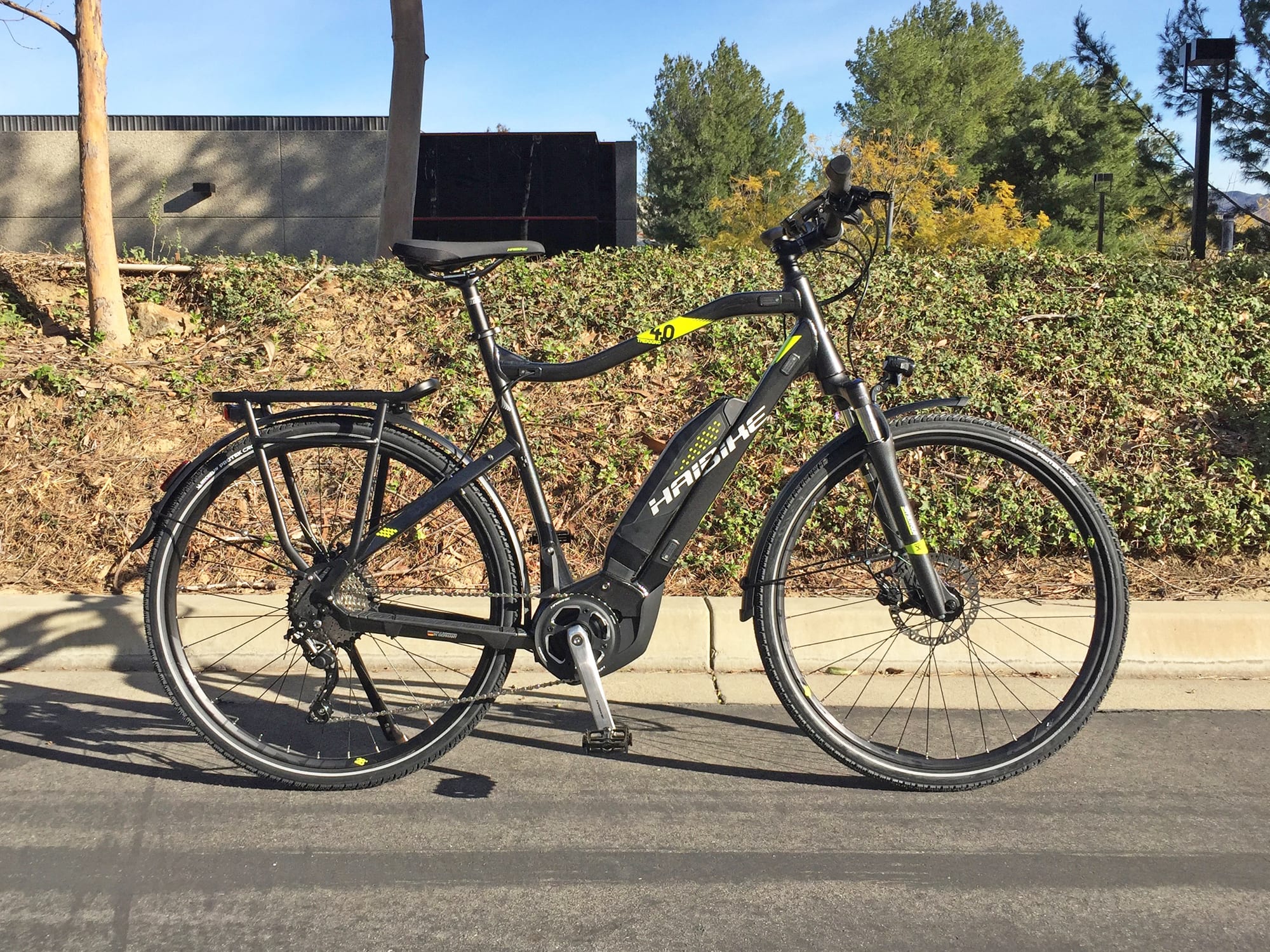
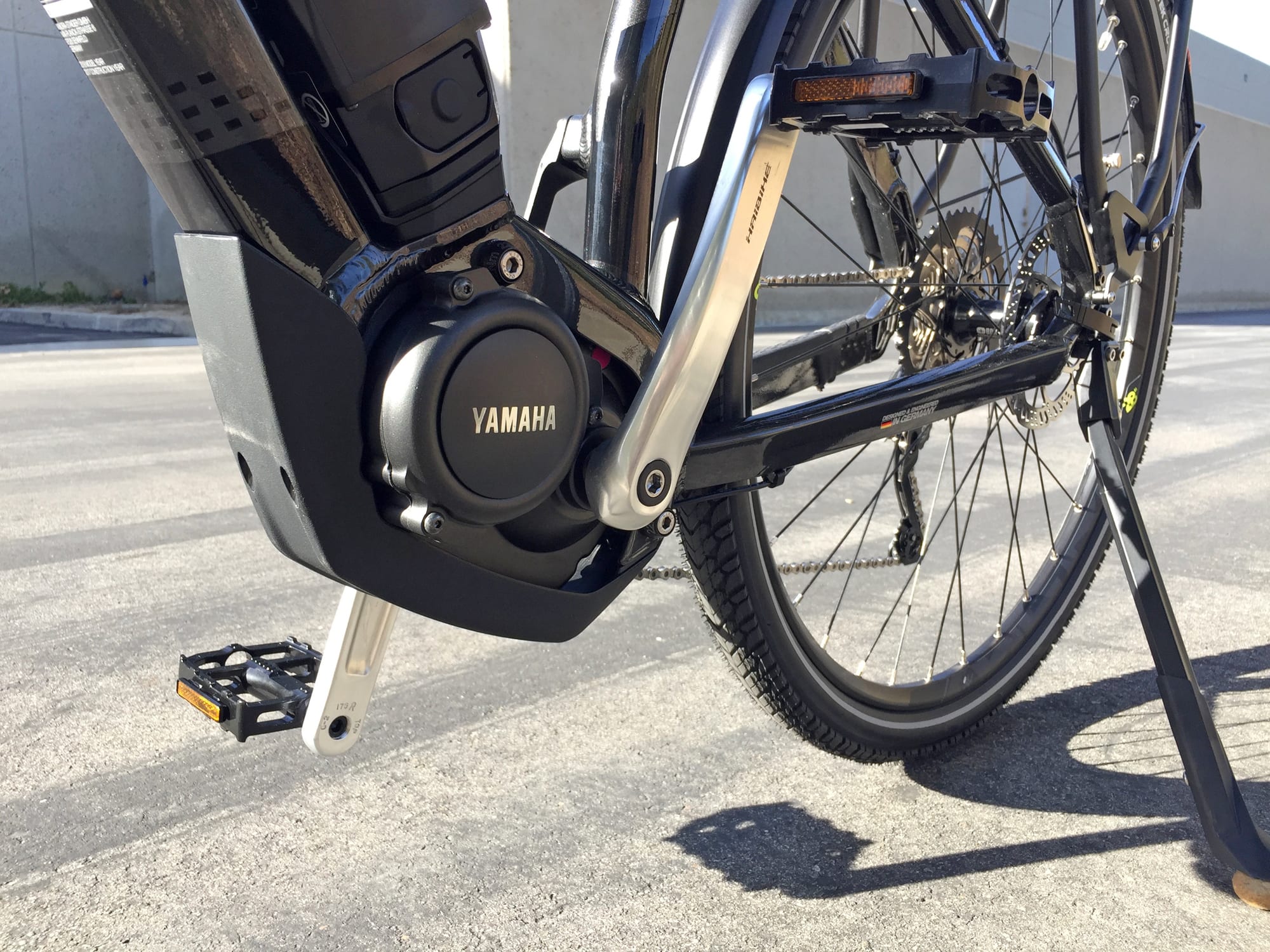
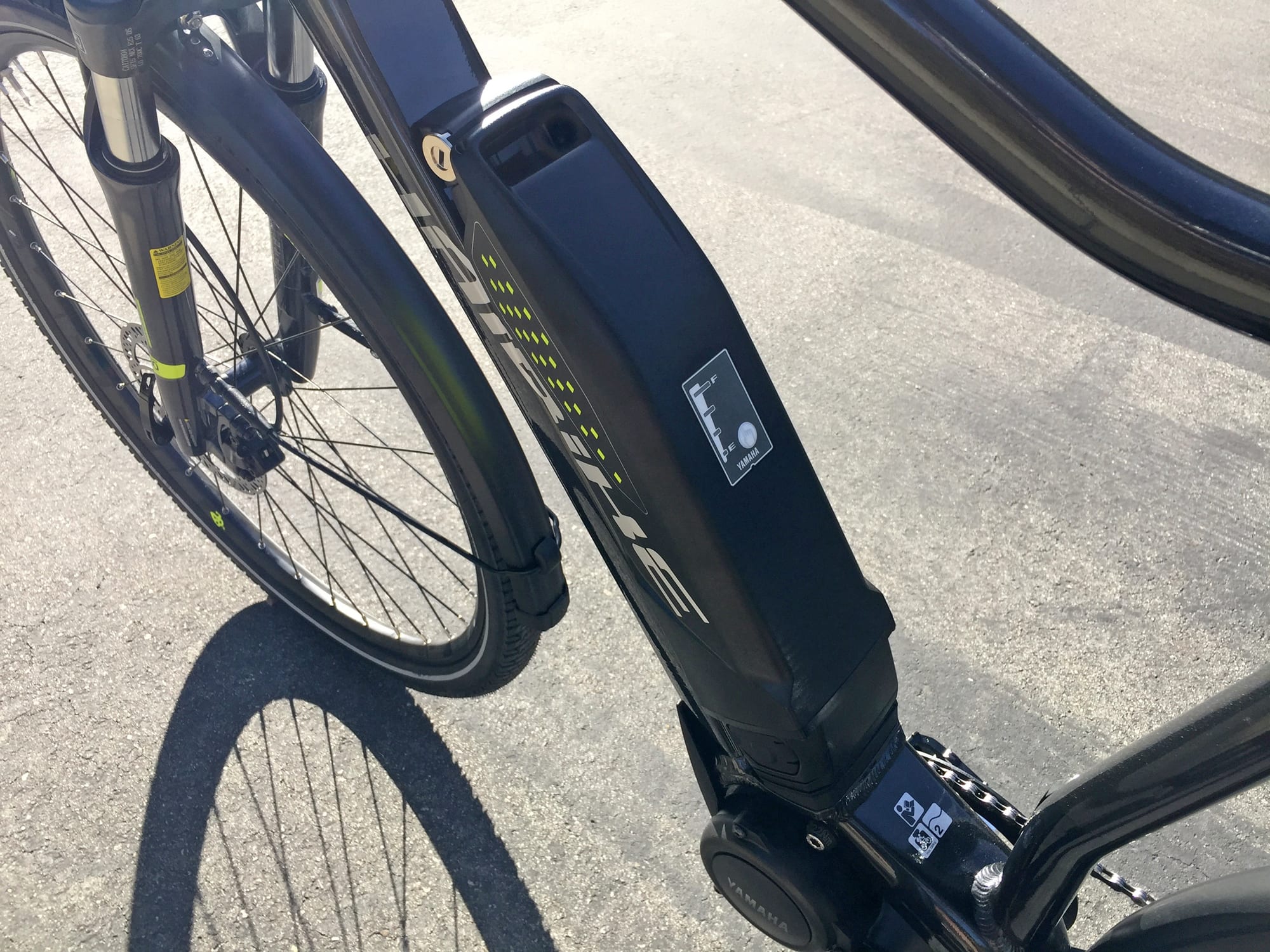
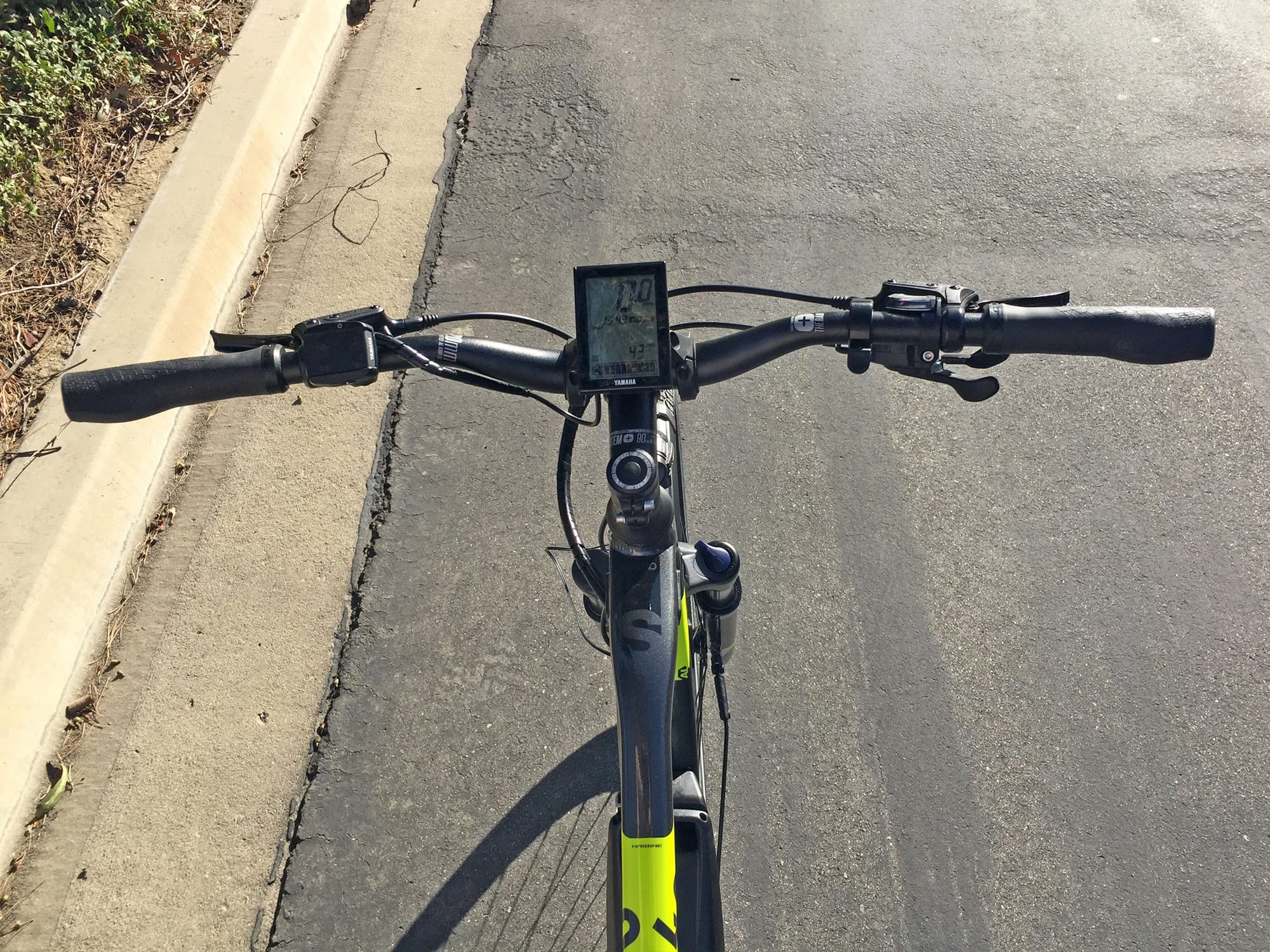
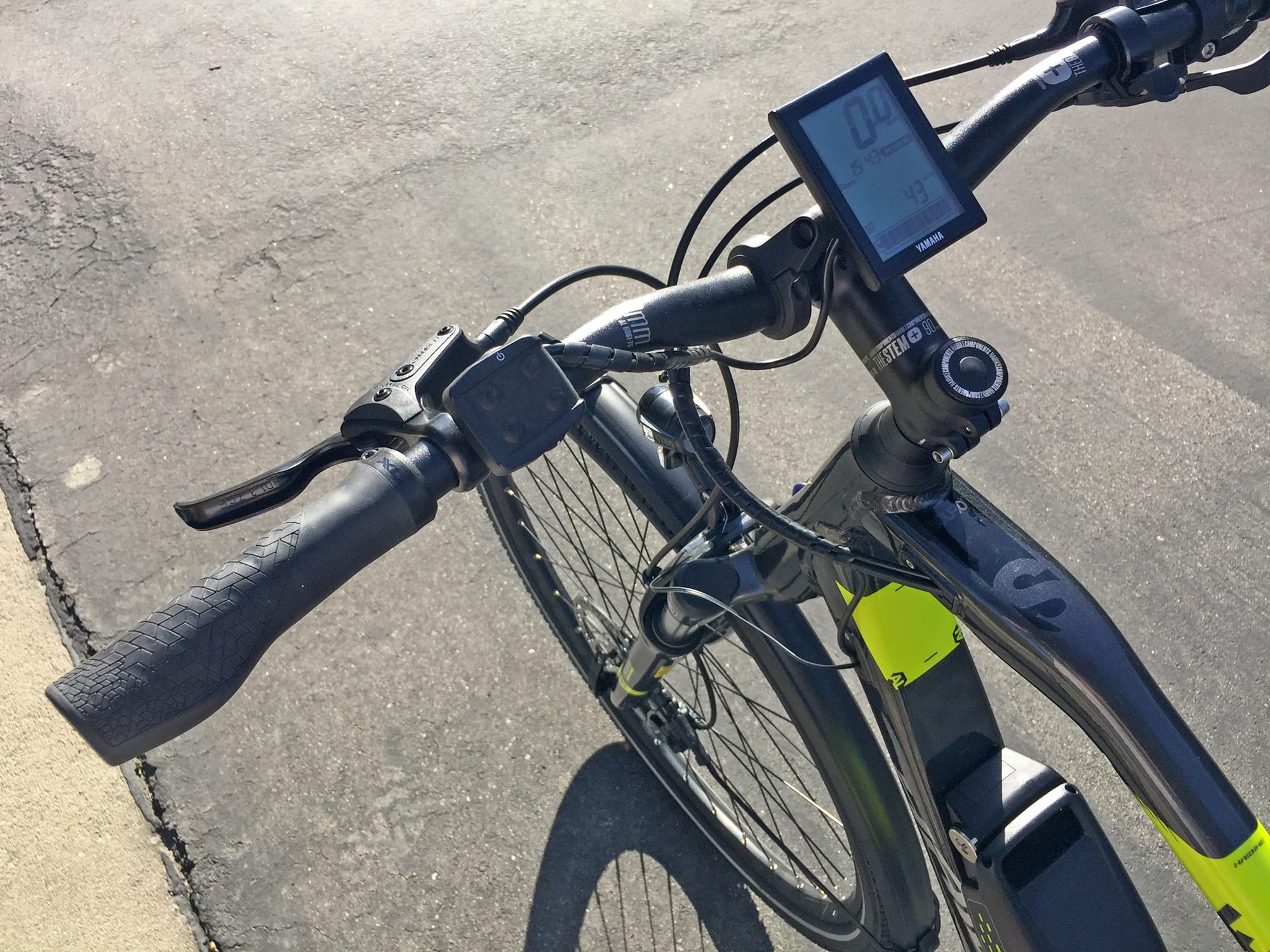
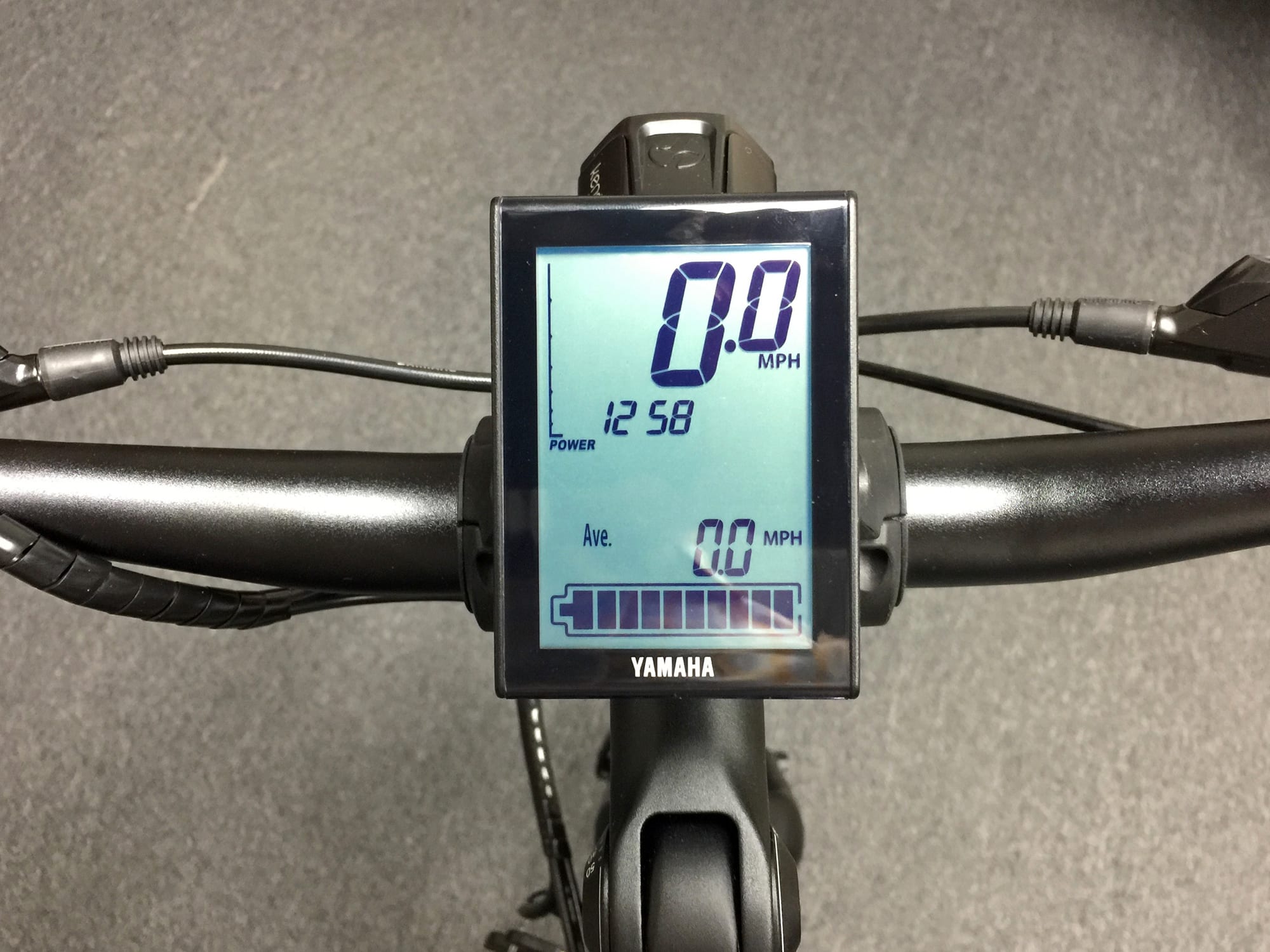
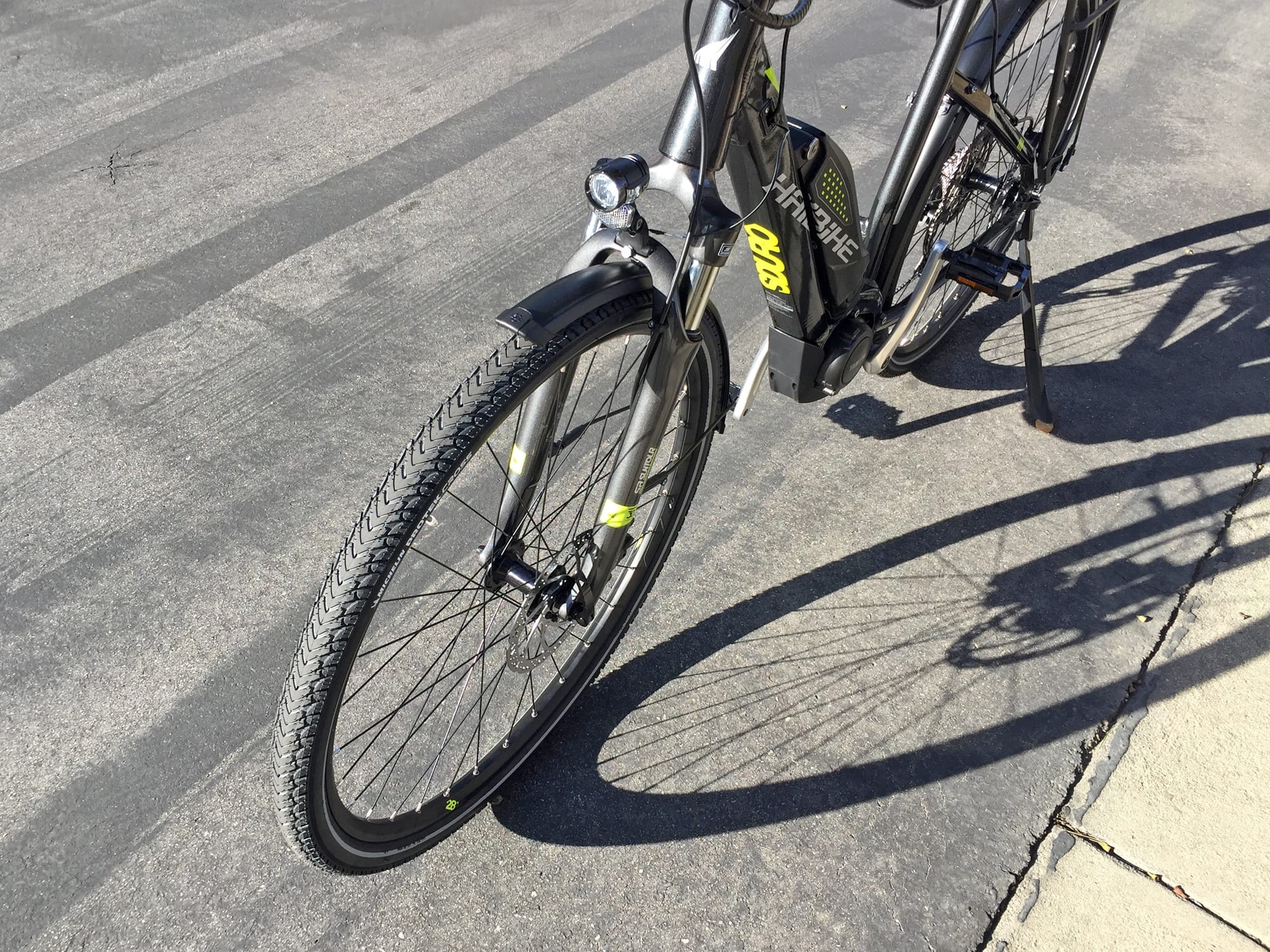
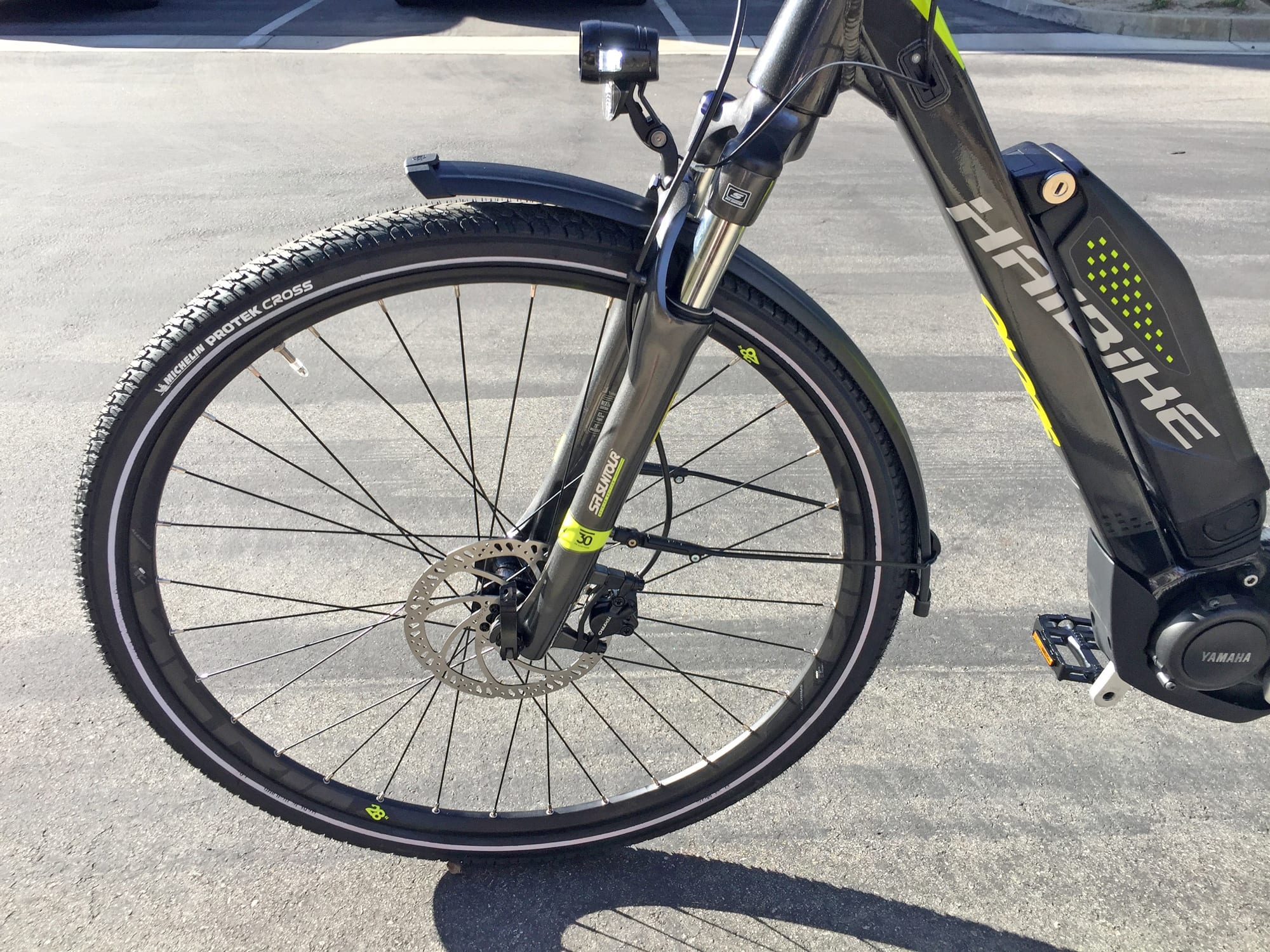
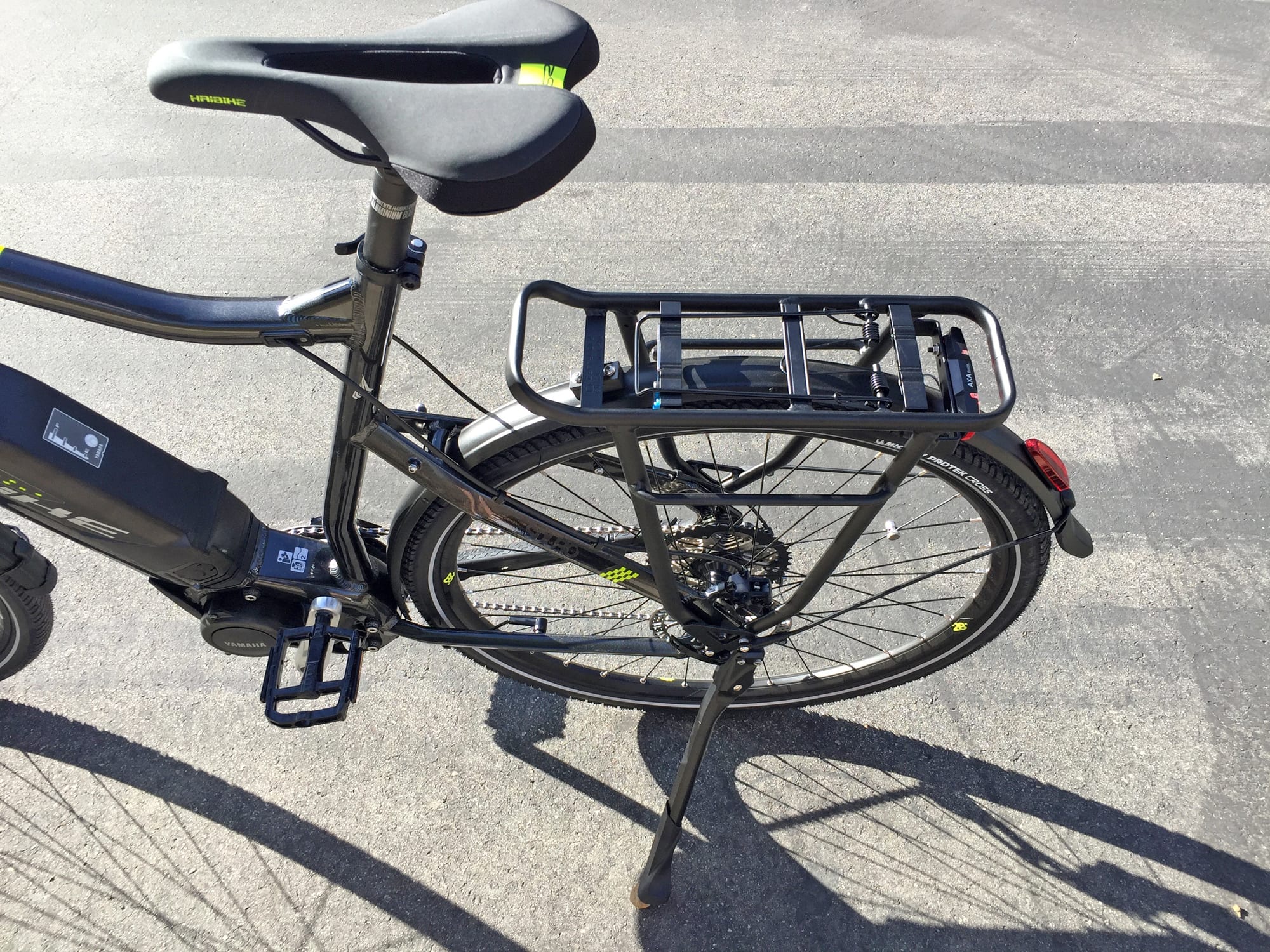
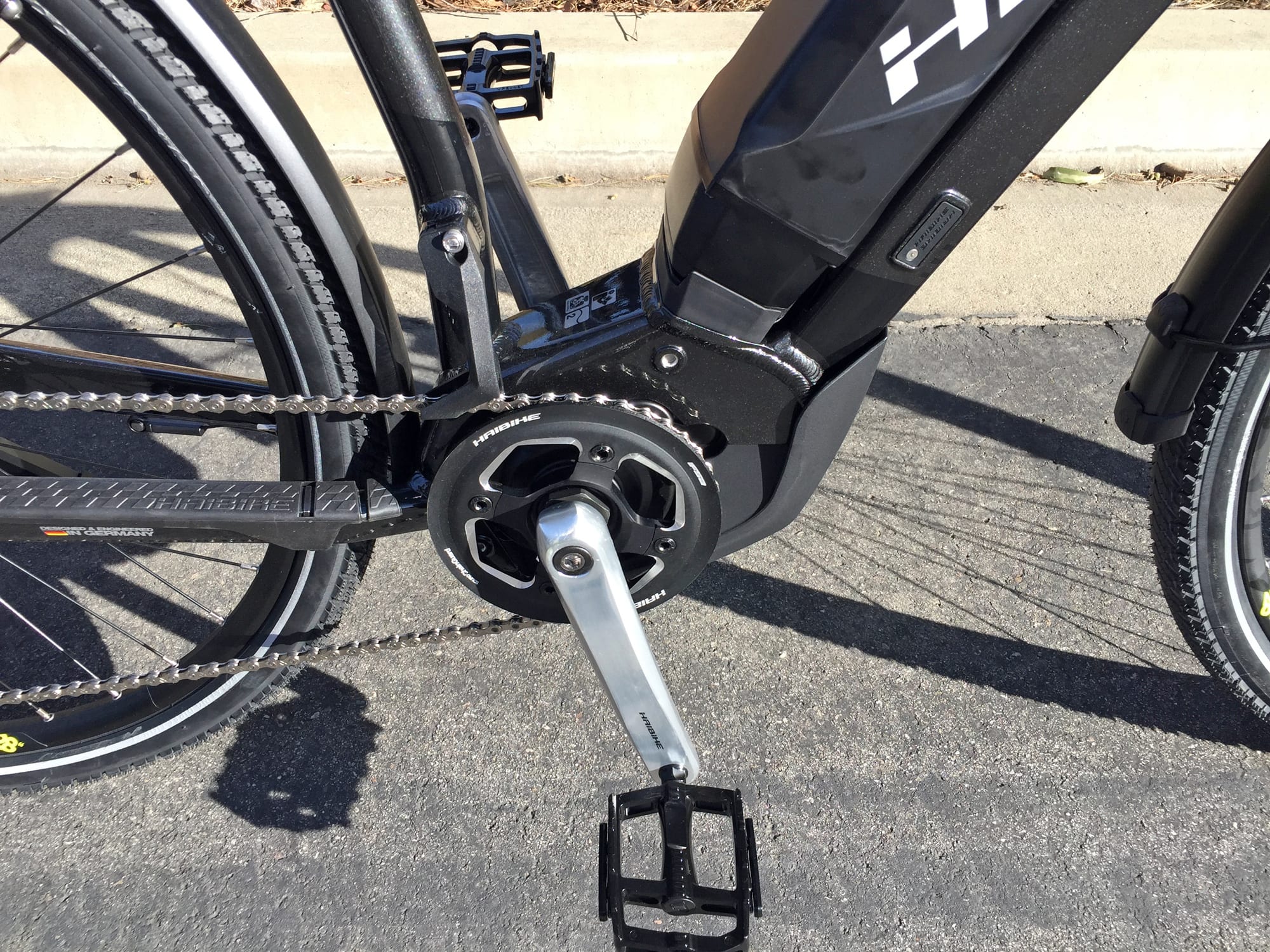
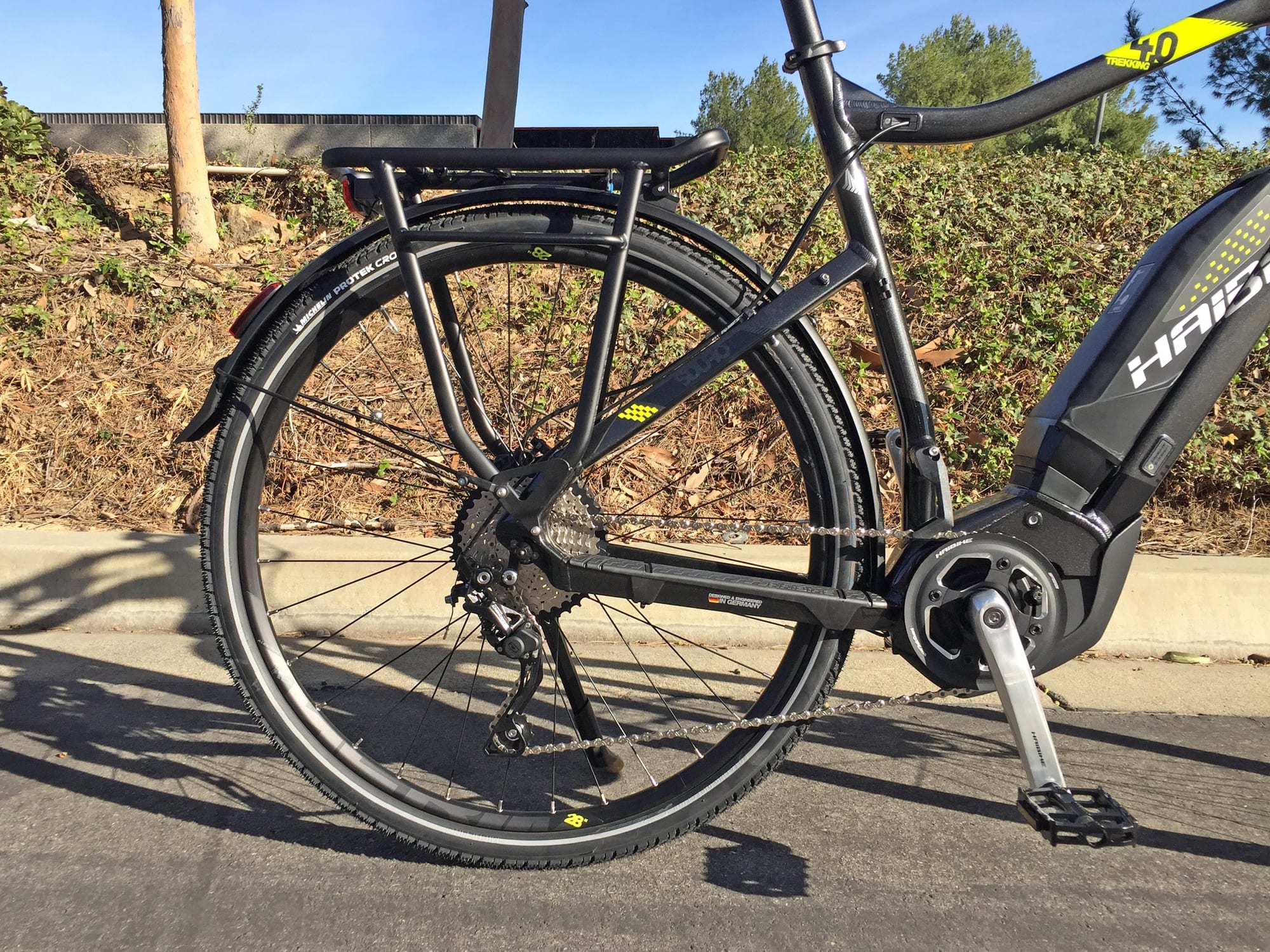
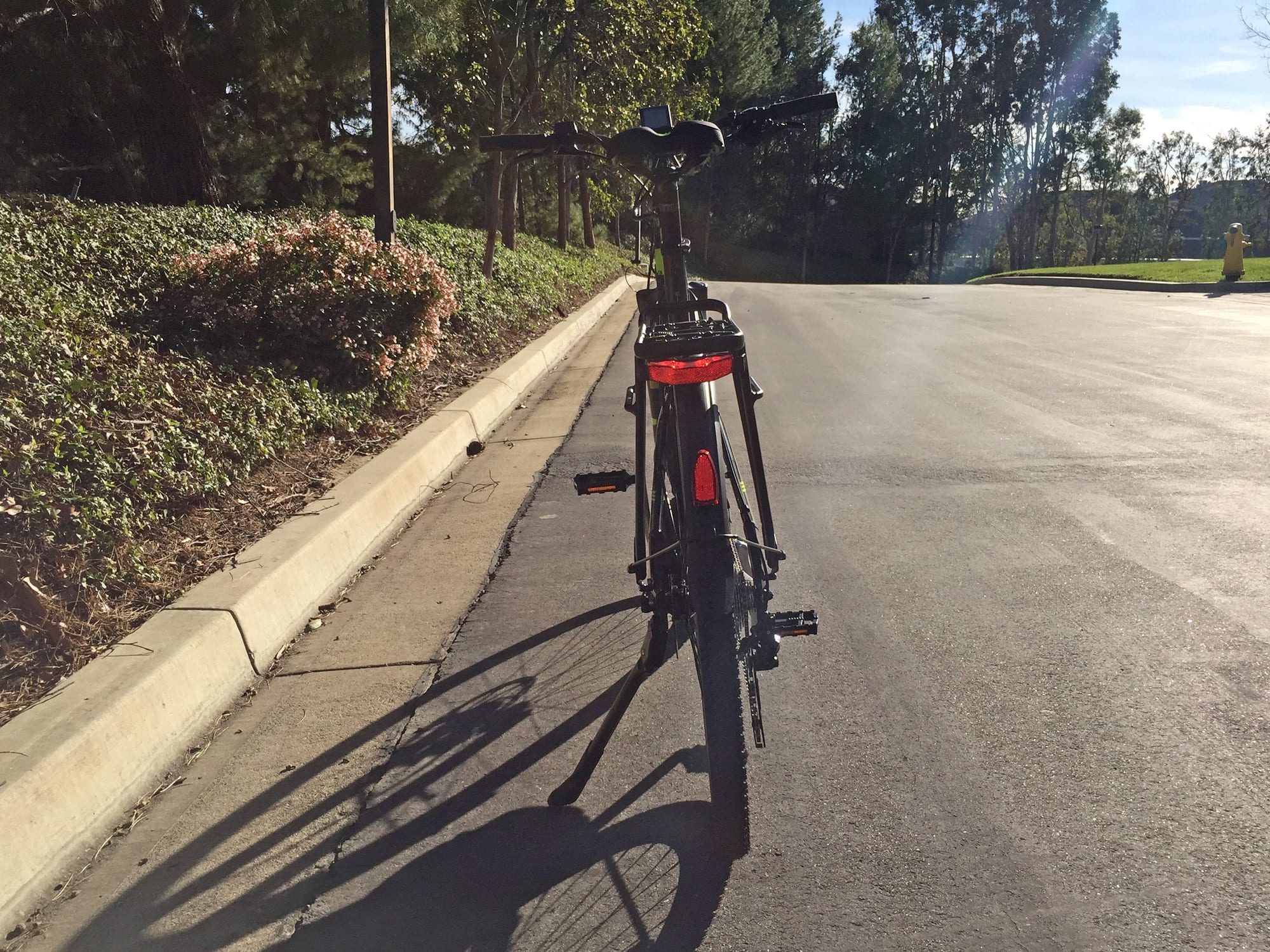
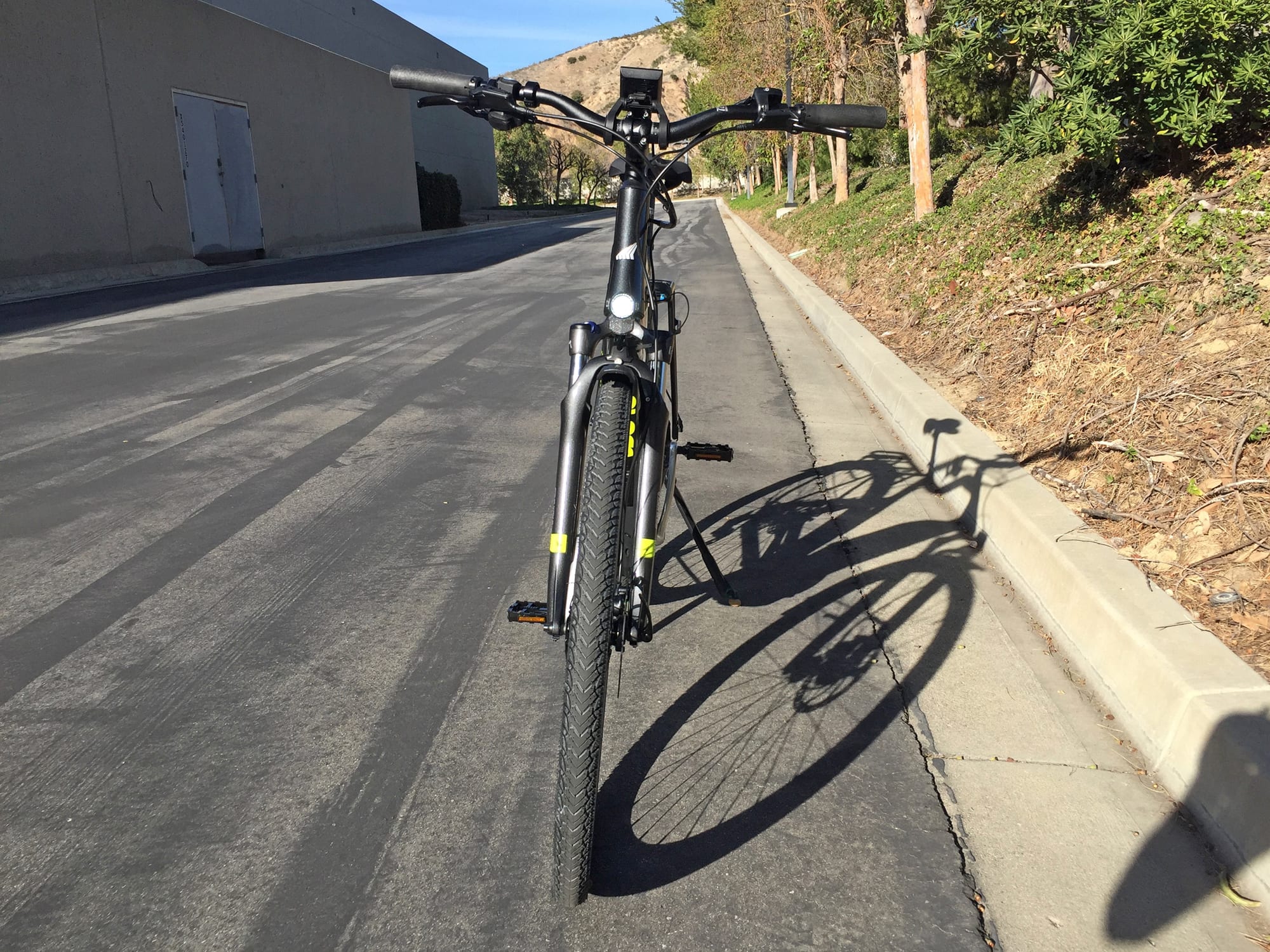
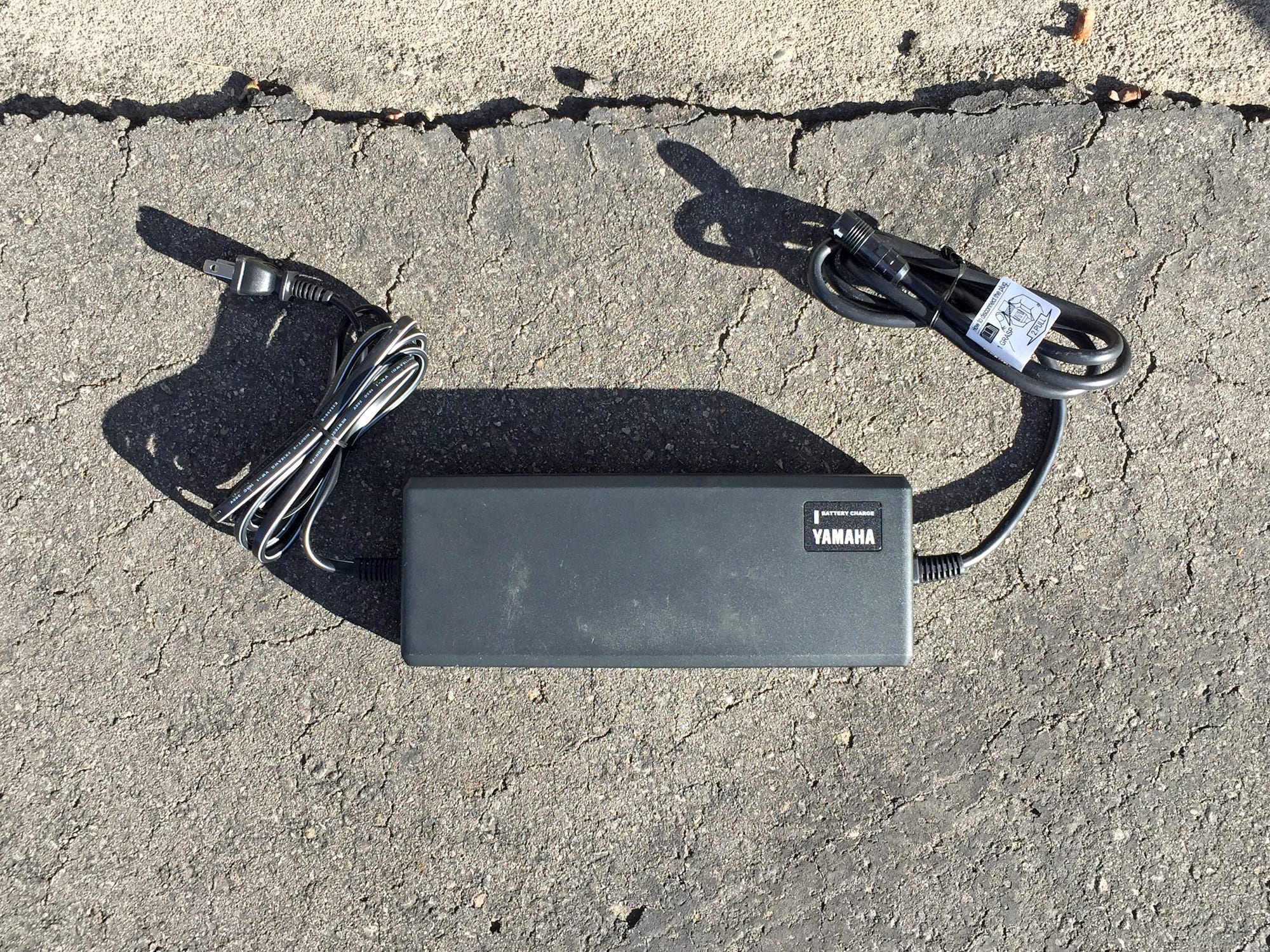
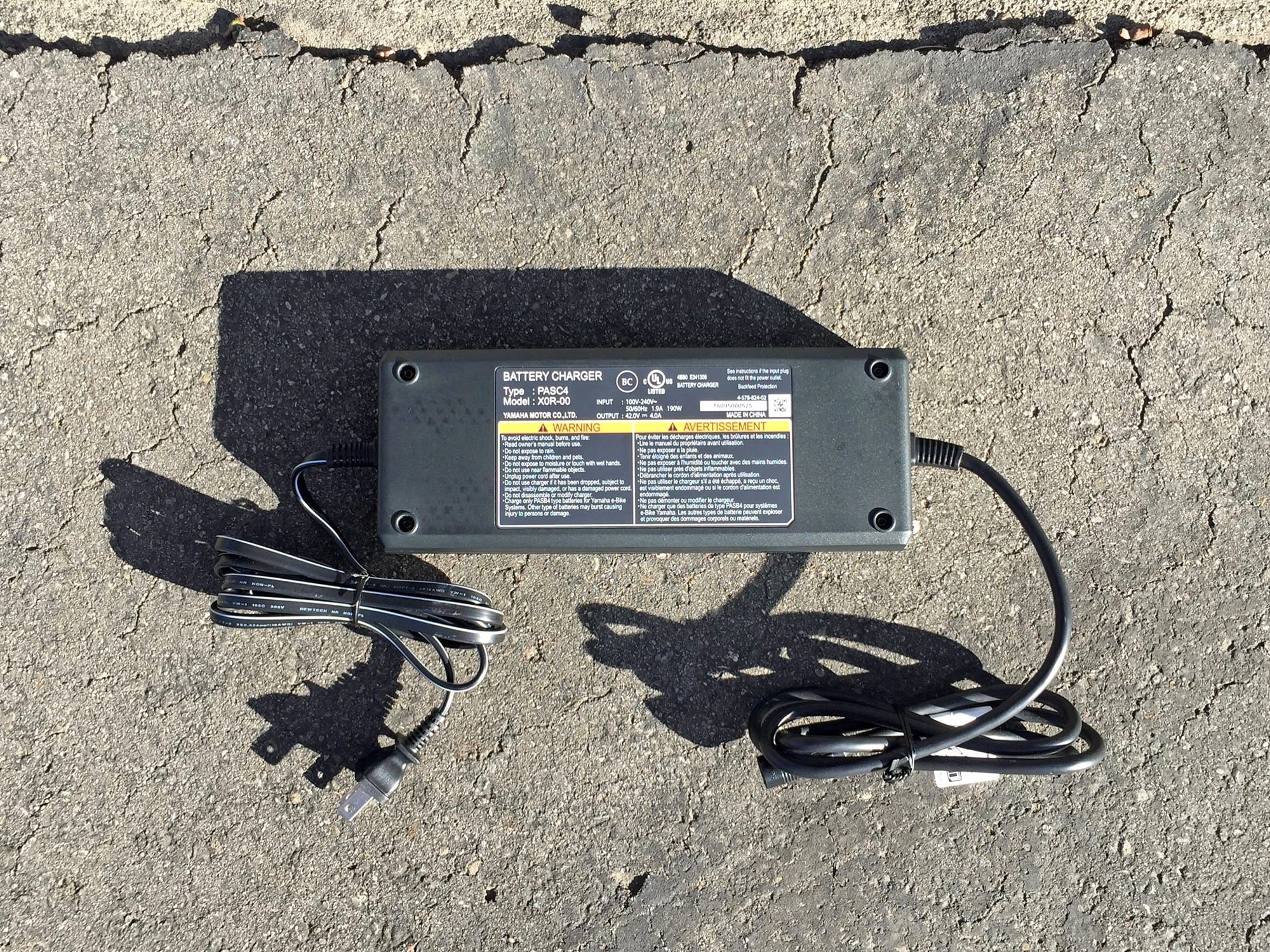

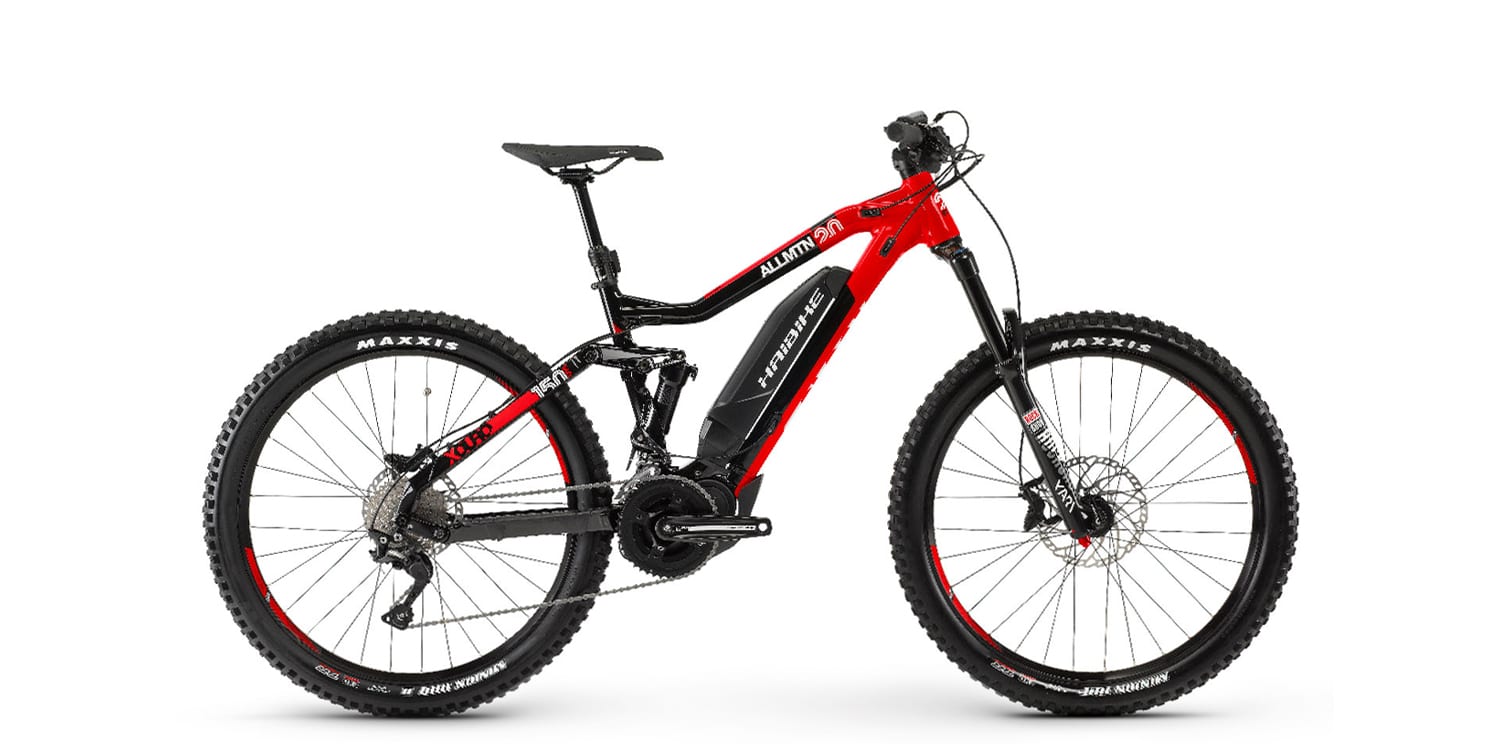
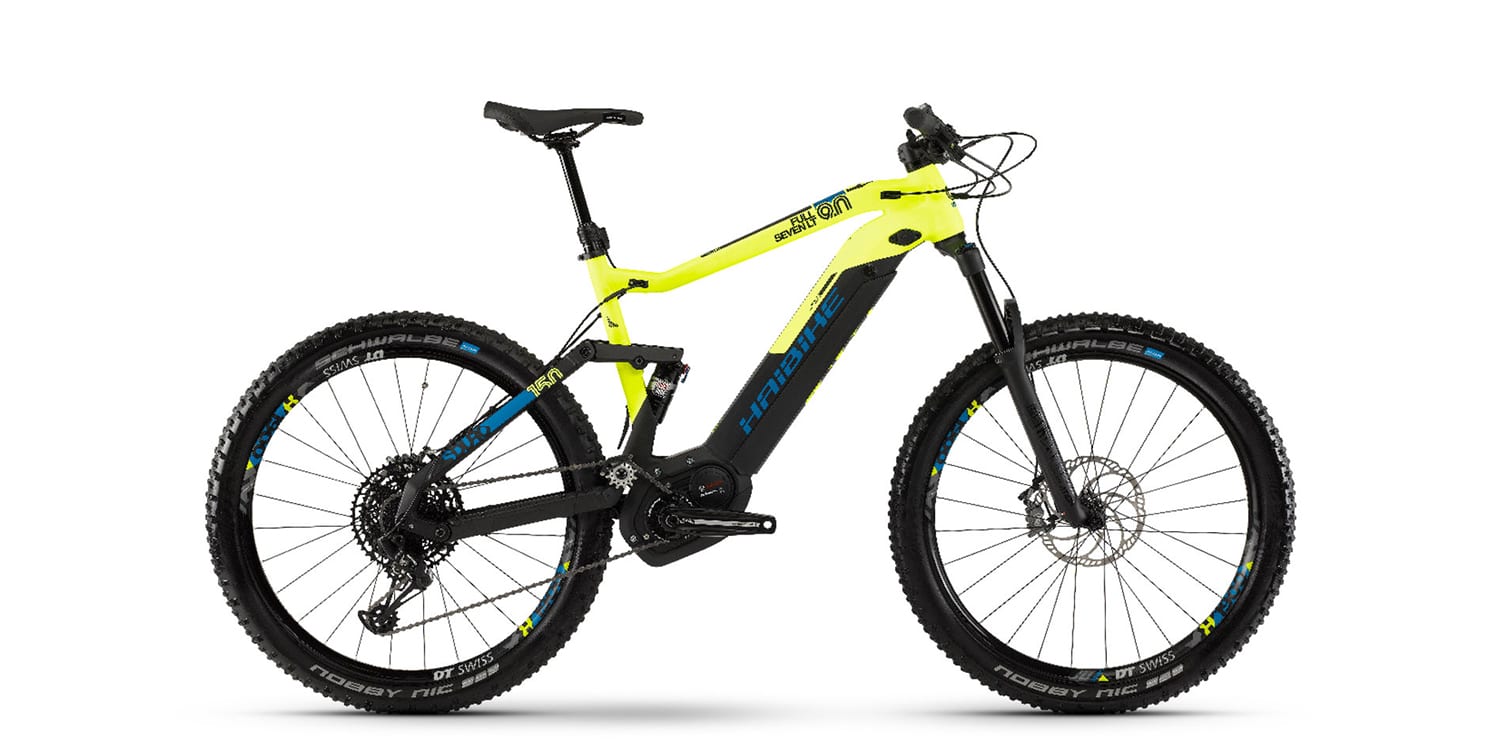
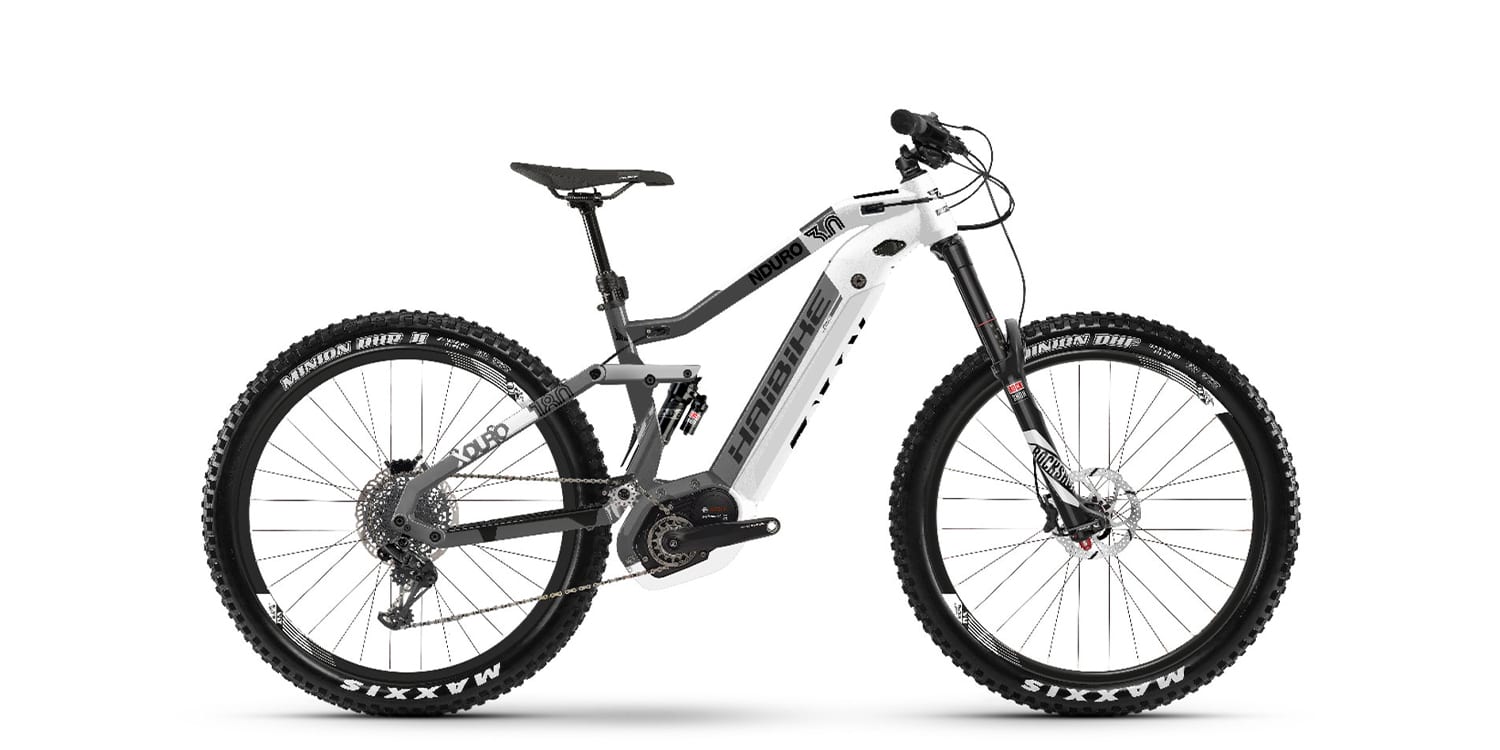
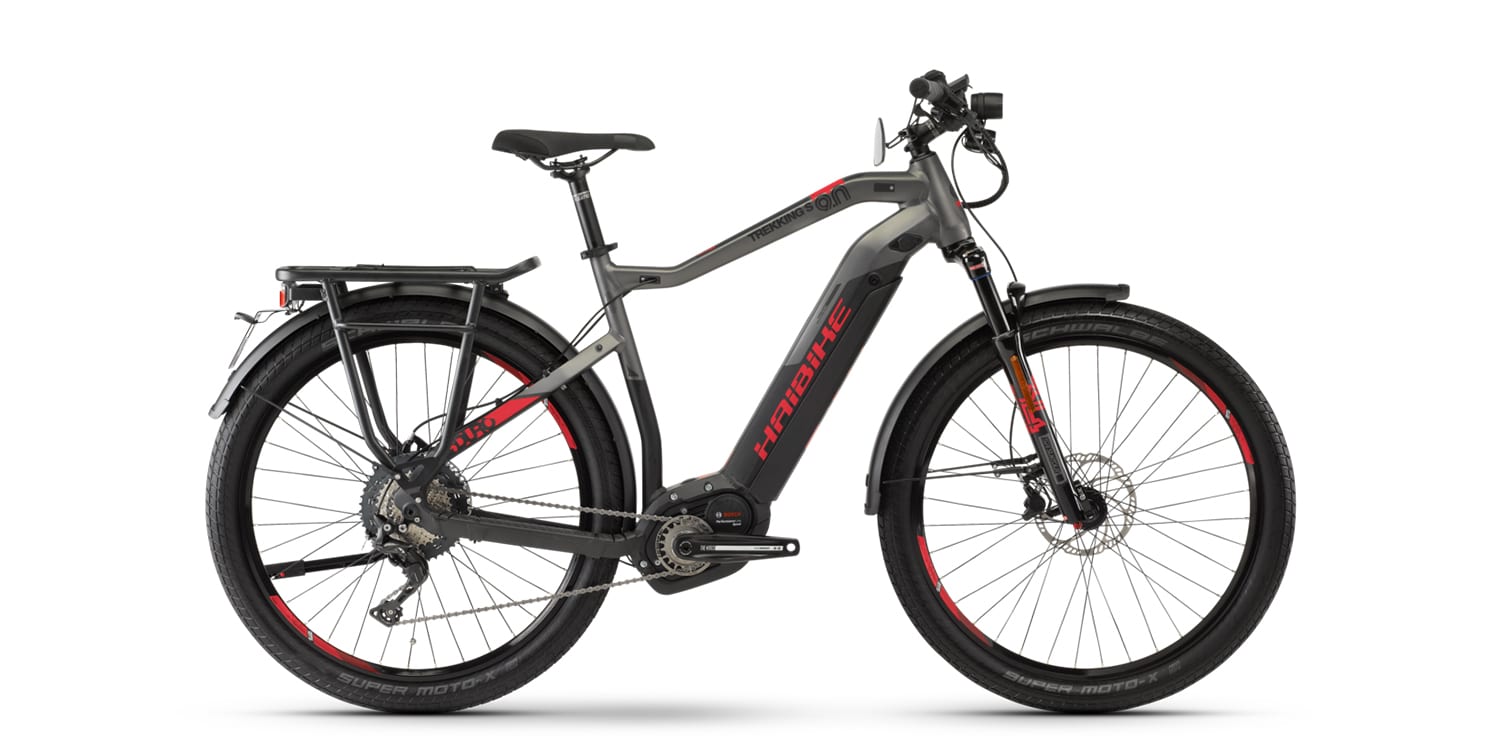
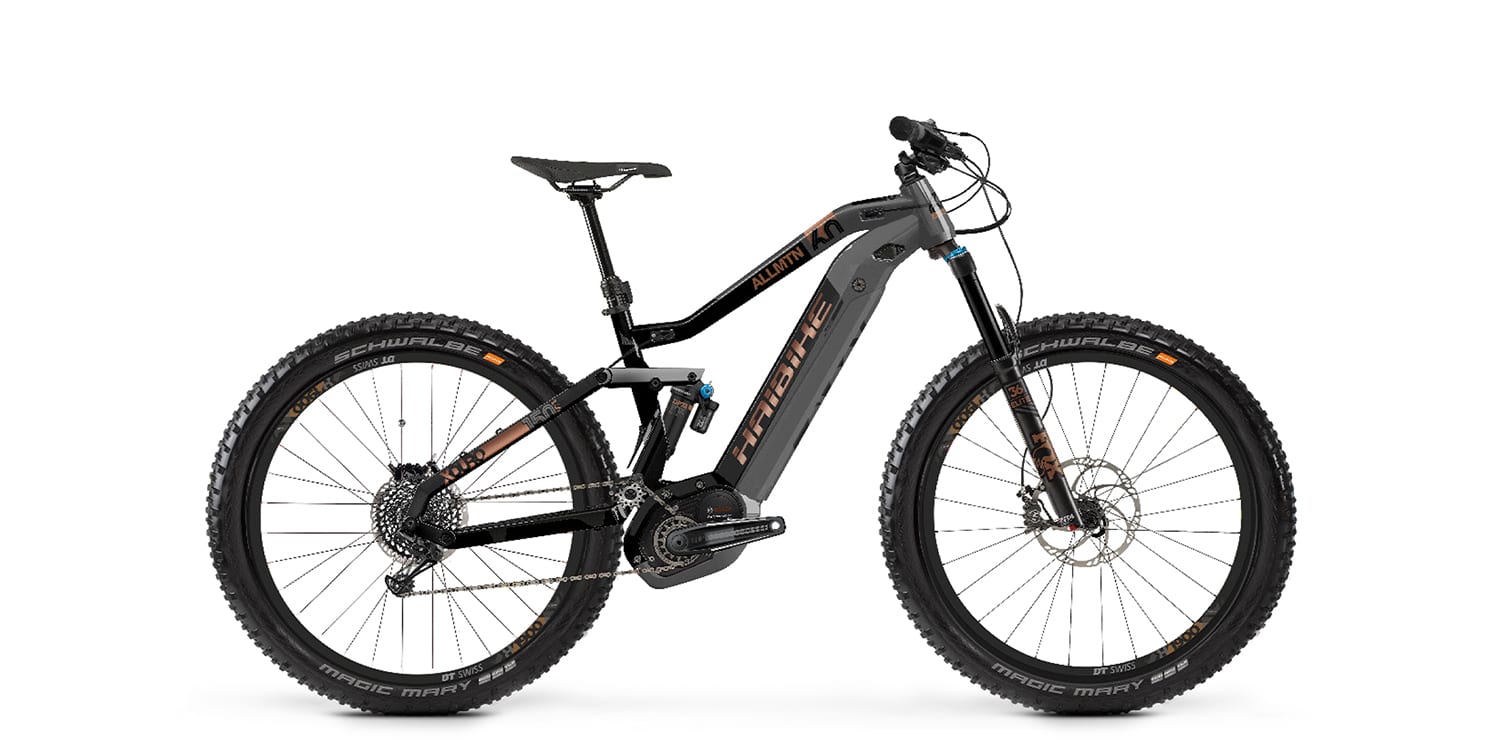
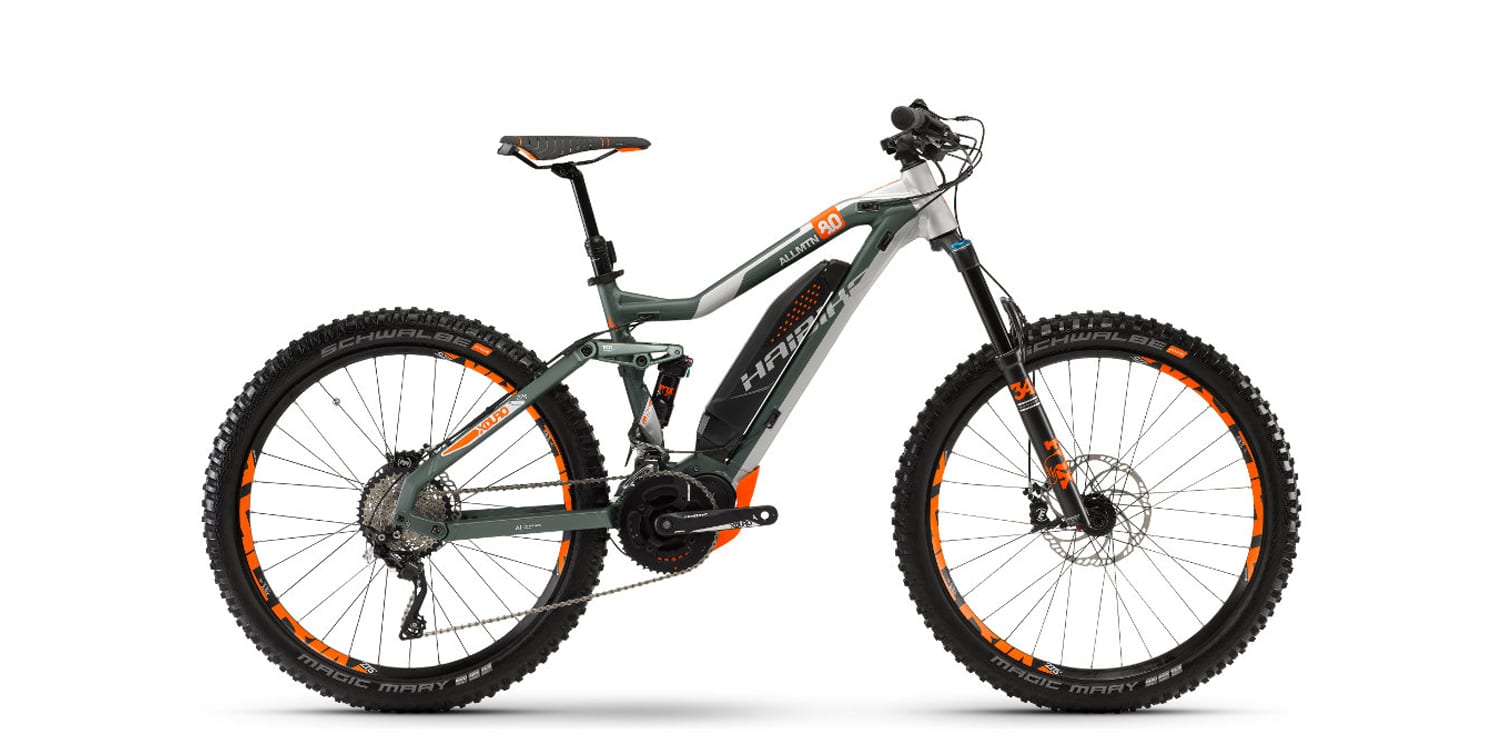
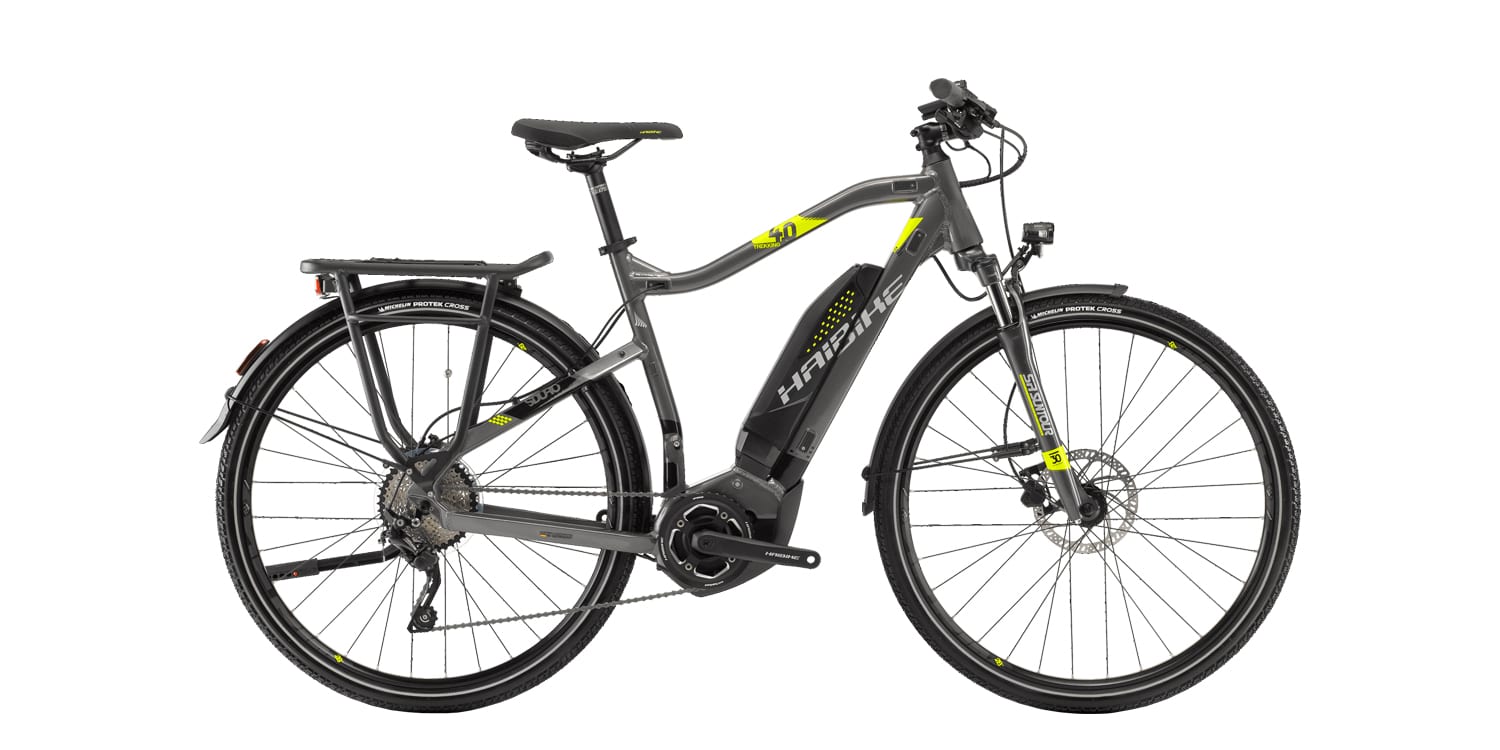
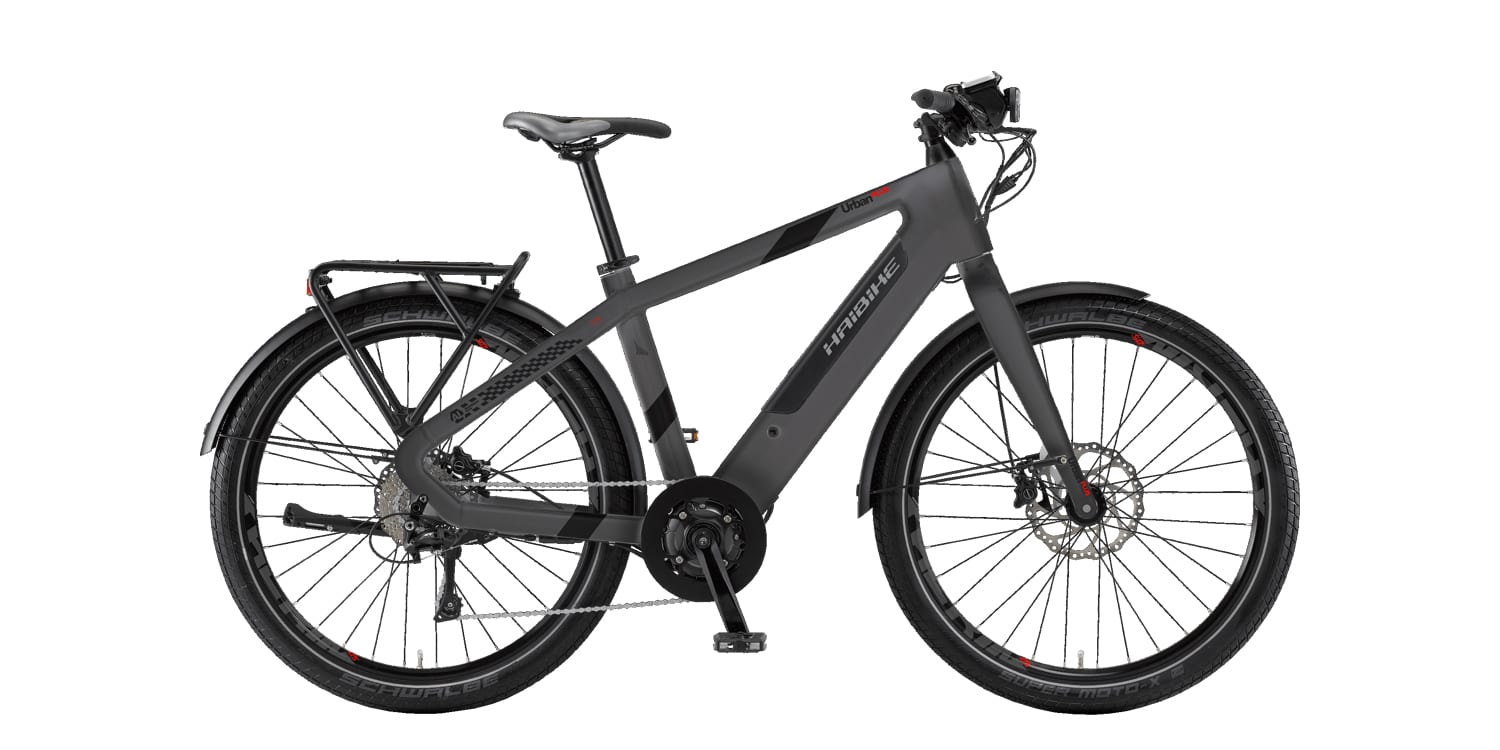
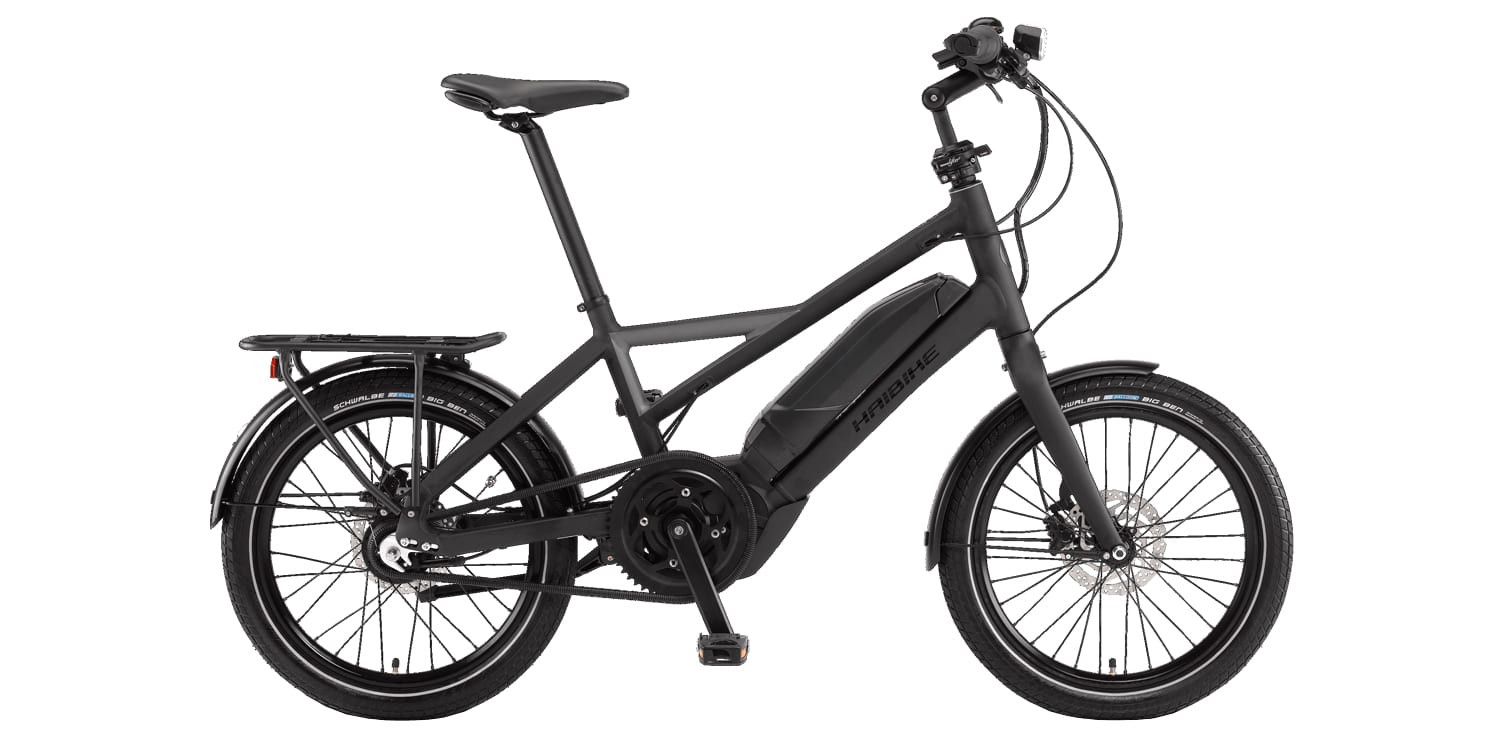
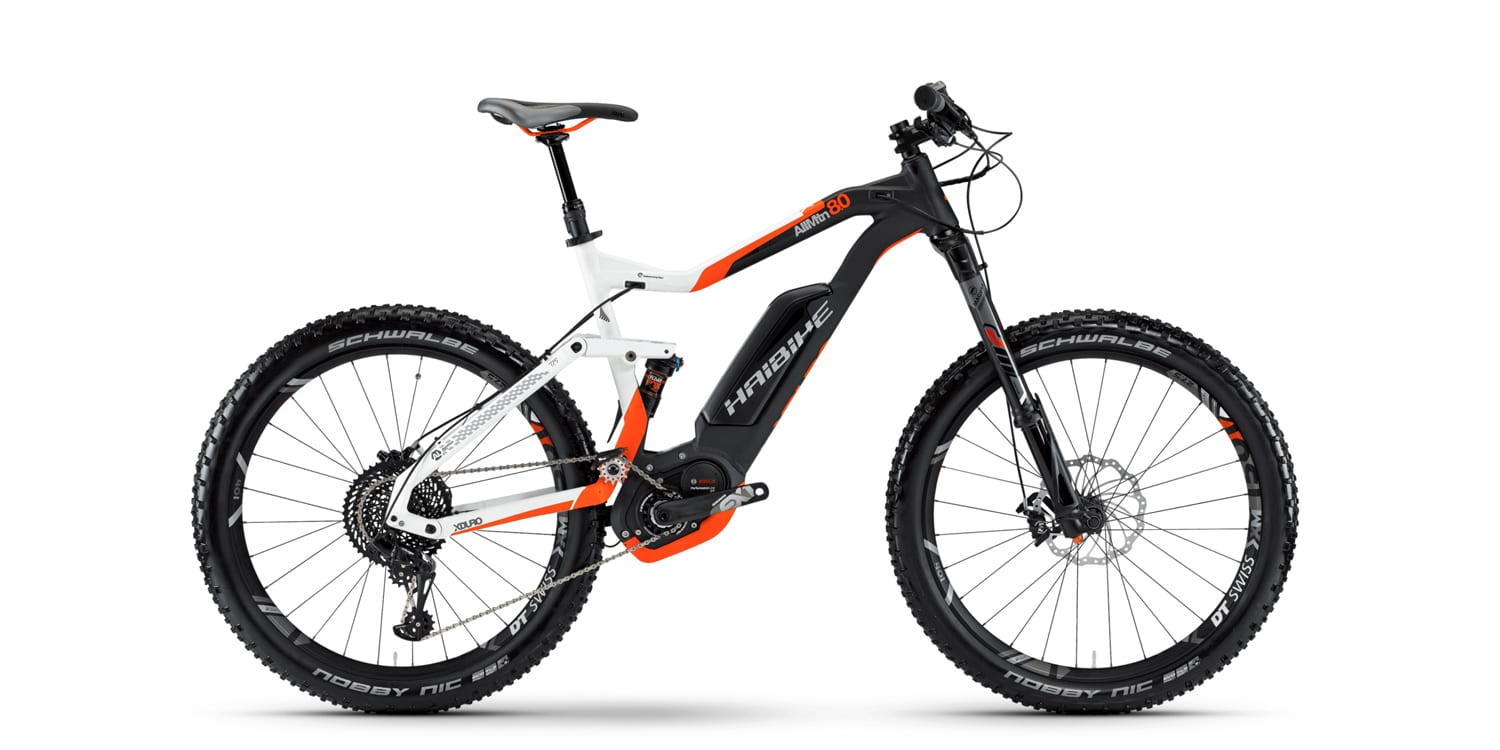
Reader Interactions